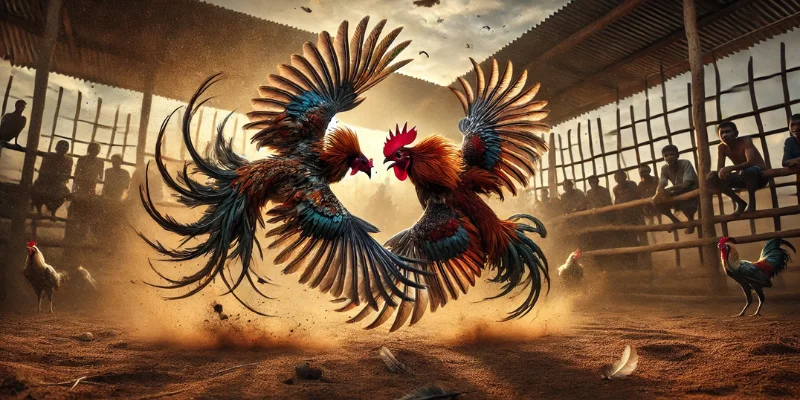
Pre-Fight Conditioning Sabong Cockfighting Matches
As a rooster breeding specialist in the Philippines, I’ve seen firsthand the difference that pre-fight conditioning can make in a rooster’s performance in the cockfighting ring. Proper training and nutrition are the cornerstones of preparing a rooster for combat. In this guide, I’ll share my proven techniques for building strength, agility, and endurance in fighting roosters. These methods have helped me, Carlos Mendoza, produce winning gamecocks time and time again.
Pre-fight conditioning is essential for preparing roosters for the intense physical demands of a cockfighting match. A well-conditioned rooster can maintain high energy levels, deliver powerful blows, and withstand fatigue longer than an untrained bird. Conditioning also reduces the risk of injury, ensuring that the rooster can perform at its peak without succumbing to exhaustion or weakness.
Without proper conditioning, even the strongest rooster may not be able to last long in a fight. Therefore, pre-fight training is not just about strength; it’s about endurance, agility, and mental preparedness.
Carlos Mendoza’s Expert Training Regimen for Roosters
I’ve developed a comprehensive training regimen that focuses on gradually building a rooster’s physical and mental stamina. This regimen is based on years of experience and research into the best practices for conditioning roosters.
Here’s an overview of my expert training regimen:
A. Initial Assessment and Conditioning Phase
Before any intensive training begins, I assess the rooster’s current physical condition. This assessment helps in tailoring a conditioning program that matches the bird’s strengths and addresses its weaknesses.
Steps for initial conditioning:
- Physical Check: Examine for injuries or illnesses. Only healthy roosters should enter the conditioning program.
- Weight Check: Ensure the rooster is at its ideal weight. Underweight or overweight birds are less agile and have poorer endurance.
- Light Exercise: Start with light exercises like free running and wing flapping to increase stamina gradually.
The initial phase typically lasts about two weeks, during which the rooster adapts to the regimen and builds a solid foundation for more intense workouts.
B. Agility Training: Building Speed and Quick Reflexes
Agility is crucial in cockfighting because the faster bird often has a significant advantage in landing attacks and dodging blows. My agility training focuses on developing quick reflexes and explosive movement.
Specific agility exercises include:
- Wing Stretching and Flapping: Encourages upper body mobility and reflex strength. Perform wing stretching exercises daily for 5-10 minutes.
- Short Sprints: These mimic quick bursts of energy needed during fights. Allow the rooster to sprint short distances, 5-6 times per session, with brief recovery periods.
- Obstacle Courses: Set up mini obstacles in the training area to force the rooster to move in zigzag patterns. This trains its legs for rapid directional changes.
Training tip: Agility training should be performed 4-5 times per week, ensuring not to overstrain the bird. Consistency is key, not intensity.
C. Strength Training: Enhancing Muscular Power
Strength is what makes a rooster’s blows devastating. A strong rooster can deliver powerful pecks and strikes with its spurs, inflicting serious damage on its opponent. My strength training regimen targets both the upper and lower body, with exercises designed to build muscular endurance.
Effective strength-building exercises include:
- Weighted Vest Runs: Attach a light weighted vest (no more than 10% of the rooster’s body weight) and have it run short distances. This adds resistance and builds leg muscles.
- Tug-of-War with a Stick: Hold a short stick horizontally, and let the rooster grab it with its beak. Lightly pull it back while the rooster resists. This strengthens the neck and chest muscles.
- Perch Hopping: Set up multiple perches at different heights and encourage the rooster to hop from one to another. This improves leg strength and balance.
Training frequency: Strength exercises should be done every alternate day, allowing the rooster’s muscles to rest and recover.
D. Endurance Training: Keeping the Rooster Active Longer
In a cockfighting match, endurance is just as important as strength. A rooster may have incredible power, but without stamina, it won’t last long. My endurance training is focused on helping roosters maintain energy throughout the fight.
Key endurance exercises:
- Long-Distance Running: Let the rooster run around an open space for 10-15 minutes continuously. This builds cardiovascular endurance and boosts overall stamina.
- Wing Resistance Training: Using light resistance bands on the wings during flapping exercises can build endurance in wing muscles.
- Treadmill Training (Optional): If available, a modified treadmill can be used to train roosters for long periods at varying speeds.
Training frequency: Endurance training is done at least 4 times per week for optimal results.
E. Sparring and Controlled Fighting Practice
To simulate the actual conditions of a cockfighting match, sparring practice is essential. Controlled fighting helps the rooster develop its natural fighting instincts and test its physical conditioning in a realistic scenario.
Sparring Guidelines:
- Short Sessions: Keep sparring sessions short, 2-3 minutes per match, to avoid injury.
- Use Protective Gear: Attach soft, blunt spurs to prevent damage during practice matches.
- Analyze Performance: After each sparring session, observe the rooster’s strengths and weaknesses. Adjust its training based on performance.
Sparring helps prepare the bird mentally for the stress and excitement of the ring, improving both its reaction time and confidence.
Specific Exercises for Enhancing Agility, Strength, and Stamina
Now that I’ve outlined the overall training regimen, let’s dive into the specifics of exercises that can help maximize your rooster’s agility, strength, and stamina.
A. Agility Exercises
- Ladder Drills: Similar to human ladder drills, set up a simple rope ladder on the ground and guide the rooster through the rungs, encouraging quick footwork.
- Pivot Training: Encourage the rooster to pivot and turn quickly in response to a light tap on the shoulder or hip. This enhances its ability to dodge in the ring.
B. Strength Exercises
- Weighted Wing Flaps: Attach small weights (1-2 ounces) to the rooster’s wings and encourage it to flap vigorously. This builds wing muscle power for stronger strikes.
- Incline Running: Let the rooster run up a slight incline, such as a hill or ramp, which builds leg strength more efficiently than flat surfaces.
C. Stamina Exercises
- Extended Sprinting: Increase the distance of sprint training gradually over time, pushing the rooster’s endurance limits.
- Interval Training: Alternate between slow jogging and short sprints during running sessions to improve cardiovascular conditioning.
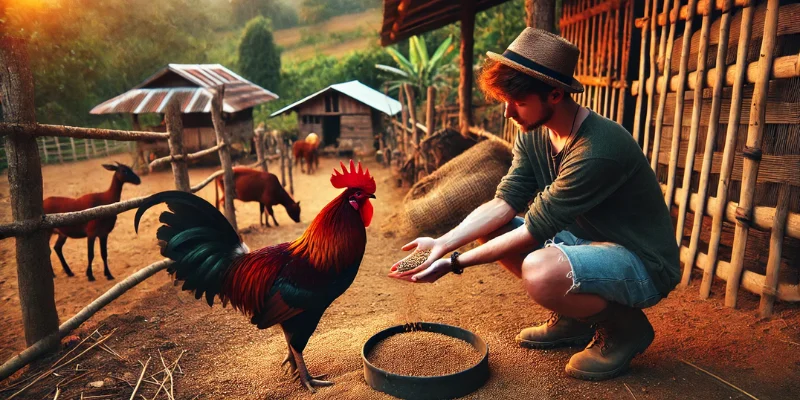 Nutritional Needs for Optimal Conditioning
Nutritional Needs for Optimal Conditioning
A rooster’s diet plays a crucial role in how well it responds to physical training. Proper nutrition ensures the bird has enough energy to endure its workouts and recover quickly afterward similar to Sexy Baccarat. I recommend a specialized diet that meets the high demands of pre-fight conditioning.
A. High-Protein Diet
Protein is vital for muscle development. It helps repair and grow muscles after intense training sessions. Feed your rooster high-quality protein sources such as:
- Pelleted feed with at least 18-20% protein content.
- Hard-boiled eggs or egg whites, which are excellent natural protein sources.
- Soybeans or mealworms as occasional treats to boost protein intake.
B. Carbohydrates for Energy
Carbohydrates are the primary energy source for roosters, especially during endurance training. Without enough carbs, your rooster will tire quickly.
- Corn: A great carbohydrate source that provides sustained energy.
- Oats: High in fiber and carbs, oats help maintain energy levels without causing digestive issues.
- Rice Bran: An affordable and nutrient-dense carb option that can be mixed into regular feed.
C. Fats for Long-Lasting Stamina
Healthy fats are essential for sustained energy and endurance. I recommend incorporating moderate amounts of:
- Flaxseed: Rich in omega-3 fatty acids, which are beneficial for heart and muscle health.
- Fish Oil: Helps with joint mobility and stamina.
D. Vitamins and Minerals
Maintaining a balanced intake of vitamins and minerals ensures the rooster’s overall health. Supplements like multivitamin powders can be added to their feed or water.
E. Hydration
Keeping your rooster hydrated is crucial, especially during intense training sessions. Always provide clean, fresh water, and consider adding electrolytes to their water source to prevent dehydration.
Hydration tip: During warmer months, ensure your rooster drinks water more frequently. Dehydration can severely impact performance.
Recovery and Rest Days
Rest is a critical component of any successful conditioning program. Overtraining a rooster can lead to fatigue and muscle damage. Incorporating rest days into the regimen allows the bird’s body to recover and come back stronger for the next training session.
A. Active Rest Days
On rest days, avoid intensive exercises. Instead, allow your rooster to roam freely in an open area. This promotes natural movement and prevents stiffness.
B. Massage and Wing Stretches
Gentle massages and wing stretches on rest days can help reduce muscle soreness and improve flexibility.
Weapons for Sabong Cockfighting Matches
As a seasoned rooster breeder and trainer in the Philippines, I, Carlos Mendoza, have spent decades perfecting the art of preparing roosters for sabong cockfighting matches. One crucial element in any cockfight is the gaff—or tari—the weapon attached to the rooster’s leg. Selecting the right gaff and maintaining it properly can determine the outcome of a fight. This article delves into the different types of gaffs, how to choose the right gaff for various fighting styles, and techniques to keep these weapons in top condition.
Gaffs in Sabong Cockfighting Matches
In sabong, the gaff is more than just a weapon—it’s an extension of the rooster’s natural fighting capabilities. The choice of gaff directly affects how your rooster fights, defends itself, and inflicts damage on its opponent. The correct selection and maintenance of a gaff can be the difference between victory and defeat.
Cockfighting has evolved, and so have the tools. In traditional sabong fitness matches, sharp metal gaffs, often referred to as spurs, are fastened to the rooster’s leg, effectively replacing its natural spurs. The use of gaffs is integral in maximizing a rooster’s fighting potential.
Types of Gaffs (Tari) Used in Cockfighting in the Philippines
The types of gaffs used in sabong cockfighting matches vary based on regional preferences, fighting styles, and match rules. There are generally three primary types of gaffs, each offering unique advantages. Understanding these can help breeders like myself tailor gaff selection to the strengths of our roosters.
A. Long Knife Gaffs
Long knife gaffs are among the most popular types used in the Philippines. These blades are long and razor-sharp, designed to deliver deep, fatal strikes. Typically measuring between 3 to 4 inches in length, long knife gaffs can quickly end a match with a single well-placed blow.
- Advantages: High lethality, quick matches, and ideal for roosters with aggressive fighting styles.
- Drawbacks: Risk of injury to the rooster due to the blade’s length, and they require precision.
When to use: Long knife gaffs are best suited for roosters that rely on speed and quick, aggressive attacks. If your bird is known for striking first, this gaff type will play to its strengths.
B. Short Knife Gaffs
Short knife gaffs are more controlled and are typically used in more strategic fights. These gaffs are about 1.5 to 2.5 inches long. They are preferred for matches that rely on endurance rather than outright killing power.
- Advantages: More control over strikes, longer fights, and better for roosters with high stamina.
- Drawbacks: They don’t offer the same one-hit lethality as longer gaffs, requiring the rooster to be more persistent.
When to use: Short knife gaffs are perfect for defensive roosters that tend to fight conservatively, waiting for the right moment to strike.
C. Round Gaffs (Slasher Gaffs)
Round gaffs are circular in shape and are more commonly used in international sabong cockfighting matches. They are favored because they mimic the rooster’s natural spur shape, allowing the bird to fight with more agility.
- Advantages: Lightweight, allows for greater mobility, and mimics natural fighting styles.
- Drawbacks: Less lethal than knife gaffs, typically leading to longer matches.
When to use: Round gaffs are ideal for roosters that are light on their feet and rely on swift movements to outmaneuver their opponents.
D. Semi-Curved Gaffs
Semi-curved gaffs offer a balance between the straight knife gaffs and the round gaffs. These are designed to deliver a hooking action, which can cause more tearing damage when a rooster lands a successful blow.
- Advantages: Increased control and high damage potential, making it versatile.
- Drawbacks: They require more skill to use effectively.
When to use: Semi-curved gaffs are suitable for experienced fighters that can land precision strikes and follow up with a series of calculated blows.
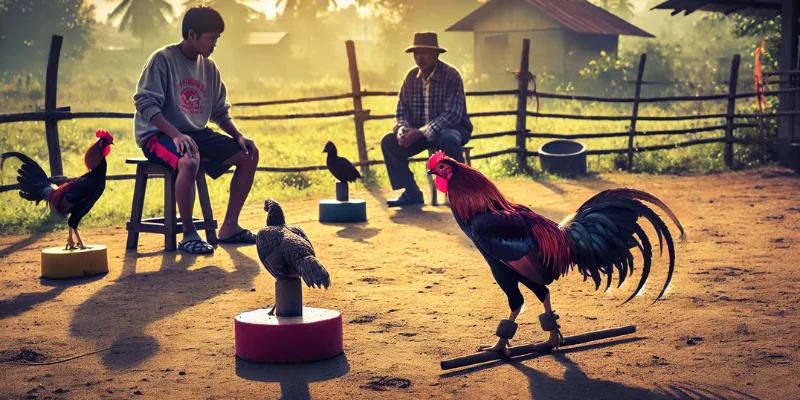 How to Select the Proper Gaff for Different Fighting Styles
How to Select the Proper Gaff for Different Fighting Styles
The selection of the proper gaff isn’t just about personal preference or tradition; it’s about choosing the right tool that aligns with your cockfighting style. As a breeder, I carefully analyze my roosters’ strengths and weaknesses before making this critical decision. Here are some factors to consider when selecting a gaff.
A. Analyze Your Rooster’s Natural Fighting Style
Every rooster fights differently. Some are aggressive, while others are more defensive. Some prefer aerial attacks, while others focus on close-quarters combat. The gaff you choose should complement your rooster’s natural tendencies.
- Aggressive Roosters: For roosters that charge head-on, a long knife gaff provides the killing power necessary to finish fights quickly.
- Defensive Roosters: If your bird tends to wait and counterattack, a short knife or round gaff offers better control and endurance.
B. Match Duration: Quick Strikes or Long Fights?
The type of fight you anticipate also influences gaff selection. If you want a quick fight, long knife gaffs offer high lethality. For longer matches where endurance matters, a short knife or semi-curved gaff will give your bird the ability to sustain attacks over time.
- Quick Matches: Long knife gaffs maximize the chances of ending the fight with one or two fatal blows.
- Endurance Matches: Short knife gaffs and round gaffs are more suitable for drawn-out battles, allowing for a steady accumulation of damage.
C. Consider the Rooster’s Physical Attributes
Your rooster’s size, weight, and agility all play into gaff selection. Heavier roosters may struggle with larger gaffs, while more agile birds can handle more aggressive tools.
- Heavier Roosters: For large, powerful roosters, a semi-curved gaff provides enough heft without sacrificing control.
- Lightweight Roosters: Lighter birds should opt for round gaffs to maintain their mobility.
D. Fight Venue and Rules
The location and rules of the match also dictate which gaff is allowed. Some venues may have strict regulations on gaff size and type, so always ensure you select a gaff that complies with local standards.
Techniques for Maintaining and Sharpening Gaffs
Maintaining your gaff is critical to ensuring its effectiveness in a sabong cockfighting match. A well-maintained gaff can strike more effectively, and proper sharpening ensures that your rooster’s weapon is always at peak performance.
A. Cleaning and Storage of Gaffs
After each match or training session, the gaffs must be cleaned immediately to prevent rust and damage. Here are the steps I use to ensure my gaffs remain in pristine condition.
- Wipe the Gaffs: Use a soft cloth to wipe off blood, dirt, and debris from the blade.
- Apply Oil: After cleaning, apply a thin layer of oil (mineral or light machine oil) to the gaff to prevent rusting. Avoid heavy oils as they can become sticky.
- Proper Storage: Store gaffs in a dry, cool place, away from moisture. Use a protective case to avoid damage or accidental dulling.
B. Sharpening the Gaffs
Sharpening a gaff requires precision and care. A dull blade reduces the effectiveness of a rooster’s strikes, while an overly sharp gaff can damage your rooster during the fight. Here are my expert tips for sharpening gaffs:
- Use a Fine Whetstone: A whetstone is the best tool for sharpening gaffs. Choose a fine grit (800-1000) to maintain control over the sharpening process.
- Sharpen in One Direction: Always sharpen the gaff in a single direction, maintaining a consistent angle (usually between 20-30 degrees) to ensure the edge is sharp but not brittle.
- Check for Sharpness: After a few passes on the whetstone, test the sharpness by gently running the edge against a soft object like cloth. It should cut easily but not tear.
- Final Polishing: Use a leather strop or soft cloth to polish the gaff after sharpening. This removes any burrs and ensures a clean, sharp edge.
C. Inspecting Gaffs for Damage
Regular inspection of gaffs is necessary to spot signs of wear and tear. Before each match, check the following:
- Cracks or Chips: Any damage to the blade can compromise its effectiveness and should be addressed immediately.
- Loose Attachments: Ensure the gaff is securely fastened to the rooster’s leg during a match. Loose gaffs can cause injury to both the rooster and its opponent.
D. Gaff Balancing
Gaffs must be perfectly balanced to ensure that the rooster can fight naturally without being weighed down or imbalanced. A well-balanced gaff provides a more fluid and powerful strike.
- Test Balance: Place the gaff on a flat surface or balance it on your fingertip at the midpoint of the blade. It should balance evenly without tipping to one side.
- Adjust if Necessary: If a gaff is unbalanced, either trim excess metal from the heavier side or replace it with a properly balanced one.
Training for Aggression and Fighting Techniques
As a rooster breeding specialist and trainer in the Philippines, I, Carlos Mendoza, have spent years perfecting the methods to train roosters for online sabong. The success of a gamecock in the ring depends on much more than just physical conditioning; a fighting rooster must possess sharp instincts, calculated aggression, and combat readiness to win. Developing these traits in a rooster requires carefully designed training programs that hone their natural abilities and prepare them for the intense demands of cockfighting.
This guide will cover how to cultivate a rooster’s fighting instincts, proven techniques to enhance aggression and combat readiness, and the best sparring practices to ensure your rooster is fully prepared for battle.
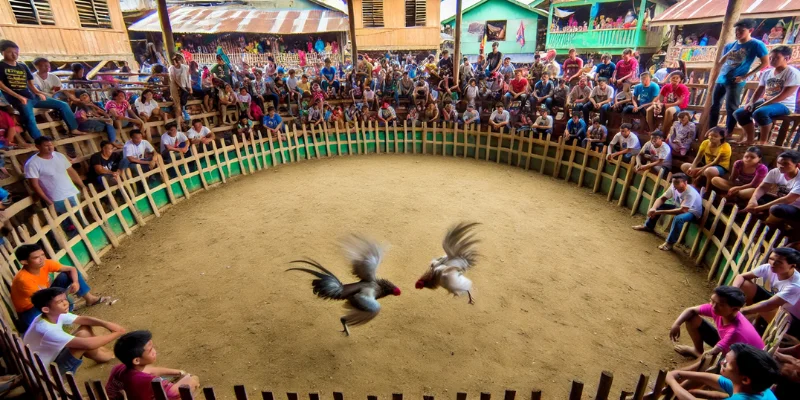 Instincts in Sabong Cockfighting Matches
Instincts in Sabong Cockfighting Matches
A rooster’s instincts are its most powerful weapons in a sabong cockfighting match. Unlike other training aspects like strength and stamina, fighting instincts are largely innate. However, with the right approach, you can sharpen and enhance these instincts to ensure that your rooster is always ready to fight.
Instinctual aggression is crucial because:
- It allows the rooster to quickly respond to attacks.
- It drives the rooster to pursue its opponent without hesitation.
- It helps the rooster defend itself effectively, knowing when to dodge and strike.
Instincts cannot be taught, but they can be developed through conditioning and training methods that mimic real combat situations.
How to Develop the Fighting Instincts of Your Rooster
To bring out the fighting instincts in your rooster, you must first understand its natural behavior. Some roosters are more aggressive, while others may need encouragement to attack. A good breeder can recognize these tendencies early and adjust their training techniques accordingly.
A. Identifying Natural Aggression
The first step in developing fighting instincts is identifying whether the rooster has a naturally aggressive demeanor. Observe the bird’s behavior in different situations:
- Aggressive Display: Does the rooster puff up its feathers or stomp its feet when challenged?
- Dominance: How does it react when placed near other roosters? Dominant birds often show immediate aggression.
- Alertness: A rooster with sharp instincts will remain alert and responsive to any movement or sound.
B. Encouraging Competitive Behavior
For roosters that show promise but lack aggression, you can stimulate their competitive behavior through exposure to controlled environments:
- Mirror Training: Place a mirror in the rooster’s pen. Seeing its reflection can trigger territorial aggression, as the rooster will think it’s confronting a rival.
- Controlled Pairing: Place your rooster near another rooster but with a barrier in between. This encourages competition without risking injury. Over time, remove the barrier for short, supervised interactions to boost confidence.
C. Triggering Natural Fighting Instincts Through Isolation
Isolation is a key technique in sharpening a rooster’s fighting instincts. A rooster that has been isolated from others for a period of time tends to develop more aggressive territorial behavior when reintroduced to competition.
- Isolation Tips: Keep your rooster separated from others for at least a week before sparring sessions. This builds anticipation and natural aggressiveness once it faces another bird.
Training Methods to Enhance Aggression and Combat Readiness
Once you’ve identified your rooster’s natural fighting tendencies, it’s time to focus on enhancing its aggression and combat readiness. The goal here is to transform instinctual aggression into focused, calculated combat behavior.
A. Focused Aggression Drills
Aggression in cockfighting is not just about being wild and uncontrollable—it must be focused and directed. These exercises will help refine your rooster’s aggressive responses:
- Flagging Exercise: Use a flag or small object to irritate the rooster without causing harm. This irritant mimics the presence of an opponent, encouraging your rooster to strike back.
- Feather Teasing: Gently brush the rooster’s face and neck with a feather. This simulates pecking and provokes a defensive or offensive response. Over time, your rooster will develop faster reflexes to potential attacks.
B. Wing and Leg Conditioning for Combat
A rooster’s wings and legs play vital roles in its combat technique. Strong wings allow the rooster to maintain balance and strike effectively, while powerful legs are essential for dodging and delivering blows.
- Wing Flapping Drills: Encourage your rooster to flap its wings regularly by lifting it up and releasing it to fly short distances. This strengthens the wings and improves balance in combat.
- Leg Resistance Training: Attach small, safe weights to the rooster’s legs during walking sessions. This builds leg strength, allowing for more forceful kicks and improved agility in the ring.
C. Aggression Timing and Control
Roosters must know when to strike and when to defend. Teaching aggression control is as important as teaching attack techniques. Use the following method to help your rooster control its aggression:
- Stop-Start Drills: During sparring or training, use a signal (like a whistle or clap) to stop the rooster mid-action. Then, after a pause, signal for it to continue. This teaches the rooster to pause before attacking, allowing it to analyze its opponent’s movements and strike at the right moment.
Sparring Practices to Prepare Your Rooster for Actual Matches
Sparring is a critical component of training roosters for sabong cockfighting matches. It simulates the conditions of a real fight, giving the rooster the chance to practice its newly developed skills. Controlled sparring also helps the handler gauge the rooster’s combat readiness.
A. The Role of Sparring in Cockfighting Training
Sparring is the rooster’s introduction to real combat. It teaches the bird to respond to live attacks, use its instincts, and hone its fighting techniques in a controlled environment. Sparring also builds the rooster’s confidence by gradually exposing it to competitive pressure.
B. Rules for Safe Sparring
Safety during sparring is essential to prevent injuries and keep your rooster in prime condition for actual matches.
- Protective Spurs: Always use blunt or soft spurs during sparring sessions to avoid cutting or seriously injuring the birds.
- Short Sessions: Limit each sparring match to 2-3 minutes. Prolonged sparring can lead to fatigue and reduce the rooster’s ability to maintain peak performance during actual fights.
- Observation: Keep a close eye on both birds during sparring. If one shows signs of exhaustion or injury, immediately end the session.
C. Progressive Sparring Levels
Gradually increasing the difficulty and intensity of sparring sessions is key to preparing your rooster for the challenges of a real cockfighting match. Start with lighter sparring and work your way up.
- Introductory Sparring: Pair your rooster with a smaller or less aggressive opponent for its first few sparring sessions. This builds confidence and allows it to test its techniques without facing overwhelming aggression.
- Intermediate Sparring: As your rooster improves, introduce it to more aggressive and skilled opponents. This helps refine its defense and offensive techniques.
- Final Sparring: Before the match, spar your rooster against a bird with similar skills and size to mimic the conditions of the real fight. This final stage of sparring ensures your rooster is prepared for all eventualities.
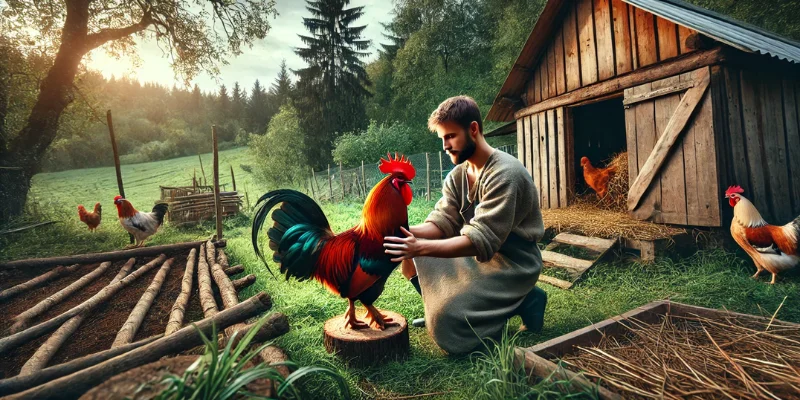 Mental Preparation for Sabong Cockfighting Matches
Mental Preparation for Sabong Cockfighting Matches
In addition to physical preparation, mental conditioning is crucial. Roosters must remain calm and focused in the heat of a match, and the pressure of the arena can be overwhelming for an untrained bird. Here’s how I mentally prepare my roosters for competition.
A. Conditioning Roosters to Fight in Front of Crowds
The noise and commotion of a sabong arena can intimidate an untrained rooster. Gradually exposing your rooster to similar conditions helps it adapt:
- Crowd Noise Simulation: Play recorded crowd noises during sparring sessions to help your rooster grow accustomed to the sounds it will hear during a real match.
- Introducing Other Birds: Place the rooster near other birds during its training to simulate the distractions it may encounter in the arena.
B. Ensuring Focus Before a Match
A distracted or anxious rooster won’t perform well in the ring. Before a match, it’s important to keep the bird calm and focused. Here’s how to mentally prepare your rooster:
- Pre-Match Isolation: Keep your rooster in a quiet, familiar environment before the match to prevent overstimulation.
- Controlled Environment Exposure: Gradually expose the bird to the match environment before its turn. Allow it to observe other fights from a distance to build confidence.
Post-Sparring Evaluation and Adjustments
After each sparring session, it’s important to evaluate your rooster’s performance and adjust its training regimen accordingly. This ensures continuous improvement and readiness for upcoming matches.
A. Analyzing Sparring Performance
Pay attention to how your rooster reacts during sparring sessions. Does it attack too early or hesitate? Does it show signs of fatigue? These observations help you fine-tune its training program.
- Aggression Level: If the rooster is too aggressive and tires quickly, focus on endurance training.
- Defensive Instincts: If the rooster struggles to dodge attacks, work on improving its agility through wing and leg exercises.
B. Adjusting Training Regimens
After each sparring match, make adjustments based on your observations:
- Improving Timing: If the rooster attacks too quickly, add more stop-start drills to teach patience.
- Building Confidence: For roosters that are hesitant to attack, increase the frequency of mirror training or controlled pairing exercises.
Last-Minute Preparations for the Cockfighting Ring
As an expert breeder and trainer in the Philippines, I, Carlos Mendoza, understand the importance of making sure your rooster is fully prepared on the day of a sabong cockfighting match. Proper training is critical, but how you handle your bird in the final hours before the fight can make or break its performance. This article will provide you with an in-depth guide to pre-match readiness, including my personal checklist, tips for handling your rooster leading up to the match, and key insights on final inspections, hydration, and ensuring peak performance.
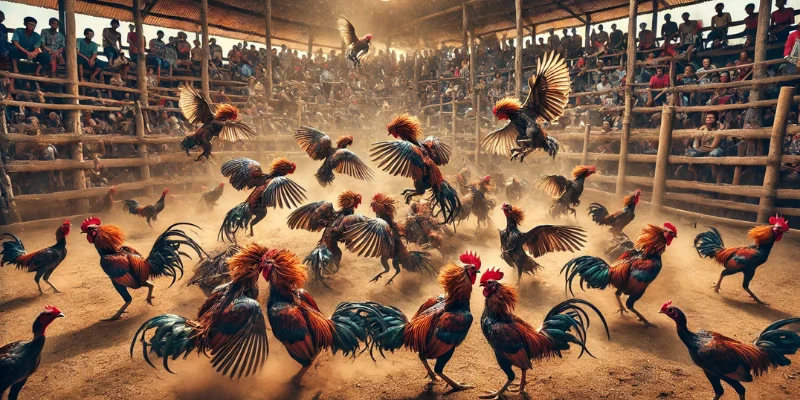 How to Handle Roosters in the Hours Leading Up to a Fight
How to Handle Roosters in the Hours Leading Up to a Fight
As the fight approaches, the way you handle your rooster can have a big impact on its mood, focus, and energy. Here’s a step-by-step breakdown of how to manage the hours leading up to the match.
A. Maintain a Calm Environment
The atmosphere you create around your rooster should be calm and controlled. Roosters are sensitive to their surroundings and can pick up on stress or tension. Keep your handling area free from unnecessary noise and distractions.
- Limit Human Interaction: Too many people crowding around the rooster can create anxiety. Keep interactions minimal and only allow experienced handlers to approach.
- Stay in Familiar Spaces: In the final hours before the match, limit your rooster’s exposure to unfamiliar environments. Keep it in its own pen or carry box until it’s time to move to the fight area.
B. Light Physical Warm-Up
A light warm-up can help your rooster loosen up its muscles and prepare for combat. Here are a few gentle exercises to get the blood flowing without tiring the bird.
- Wing Flapping: Gently encourage the rooster to flap its wings. This exercise stretches the muscles and promotes circulation without causing fatigue.
- Short Sprints: Allow your rooster to move freely within a small, enclosed area for short bursts of energy. This simulates the quick movements it will need during the fight.
Tip: Avoid intense or prolonged exercise at this stage. Overworking your rooster just before the fight can deplete its energy reserves.
C. Monitor for Signs of Fatigue or Stress
The hours leading up to a match are critical for assessing your rooster’s overall condition. Be vigilant for signs of stress or fatigue, as these can compromise its performance in the ring.
- Panting or Heavy Breathing: Roosters under stress will often show signs of heavy breathing. If your bird is panting, place it in a cool, quiet area and ensure it has access to fresh water.
- Agitation or Excessive Movement: Some roosters may become overly agitated in the hours before a fight. If this happens, reduce stimulation and give the bird time to rest in a dim, quiet environment.
Ensuring Everything is Set for Peak Performance
The last step before bringing your rooster to the ring is conducting a thorough final inspection. This ensures that no last-minute issues will affect its performance.
A. Physical Inspection: Head to Toe
Before placing your rooster in the ring, check it one last time for any signs of injury, illness, or abnormalities. Start at the head and work your way down, being meticulous in your inspection.
- Beak and Comb: Look at the comb and wattles for signs of discoloration. A healthy comb should be bright red, indicating good circulation and health. Check the beak for cracks or chips.
- Feet and Legs: Pay close attention to the feet and legs, ensuring that they are free of cuts, swelling, or other signs of injury. The legs should be strong and firm, showing no signs of weakness.
- Wings and Feathers: Inspect the feathers for cleanliness and alignment. Make sure there are no loose or damaged feathers that could impair the bird’s balance during the fight.
B. Gaff Inspection: Ensure Proper Fit and Sharpness
One of the most critical components of cockfighting preparation is ensuring the gaffs or spurs are in perfect condition.
- Check the Fit: Make sure the gaffs are securely fastened to the rooster’s legs. They should not be loose or wobble during movement.
- Sharpness Test: Lightly test the sharpness of the gaffs with your fingertip. They should be razor-sharp without being too brittle. Dull gaffs will hinder performance, while overly sharp gaffs may cause unintended injury.
C. Final Hydration and Energy Boost
Hydration is key to maintaining stamina in the ring, but it needs to be managed carefully. Too much water can slow your rooster down, while too little can lead to early fatigue.
- Small Sips of Water: Offer your rooster small sips of water 30-45 minutes before the fight. Avoid giving too much water, as this can lead to lethargy.
- Electrolytes for Energy: If available, add a small dose of electrolytes to the water to boost hydration levels. This will help your rooster maintain its stamina throughout the match.
- Last-Minute Energy Source: Provide a small, easily digestible snack 30 minutes before the match. This could include a few grains or a small piece of fruit to offer a quick energy boost.
Conclusion
Pre-fight conditioning is a multifaceted process that involves building strength, agility, and stamina while ensuring proper nutrition and recovery. Through careful training, diet management, and rest, you can prepare your rooster to perform at its best in the ring.
In sabong cockfighting matches, selecting and maintaining the right gaff can give your rooster a significant advantage. The type of gaff you choose should align with your bird’s fighting style and physical attributes. Equally important is the care and maintenance of the gaff to ensure peak performance. With the proper techniques for cleaning, sharpening, and balancing, your rooster will be equipped with a weapon that maximizes its natural abilities in the ring. As a breeder with decades of experience, I know that the right gaff can be a game-changer in any match.
My methods, honed over years of experience as a breeder, are designed to bring out the natural abilities of each bird, ensuring they are not only strong but also agile and enduring. Follow this guide, and your roosters will have the best chance for success in the competitive world of sabong.
